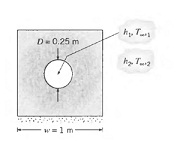Solve the below:
Q: We assumed that, whenever fins are attached to a base material, the base temperature is unchanged. What in fact happens is that, if the temperature of the base material exceeds the fluid temperature, attachment of a fin depresses the junction temperature below the original temperature of the base, and heat flow from the base material to the fin is two-dimensional.
Consider conditions for which a long aluminum pin fin of diameter D = 5 mm is attached to a base material whose temperature far from the Junction is maintained at Tb = 100°C. Fin convection conditions correspond to h = 50 W/m2 · K and T8 = 25°C.
(a) What are the fin heat rate and junction temperature when the base material is
(i) aluminum (k = 240 W/m. K) and
(ii) stainless steel (k = 15 W/m · K)?
(b) Repeat the foregoing calculations if a thermal contact resistance of Rt,j = 3 x 10-5 m2 . K/W is associated with the method of joining the pin fin to the base material.
(c) Considering the thermal contact resistance, plot the heat rate as a function of the convection coefficient over the range 10 < h="">< 100="" w/m2="" ·="" k="" for="" each="" of="" the="" two="">
